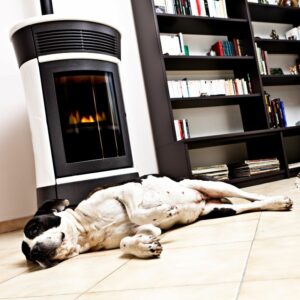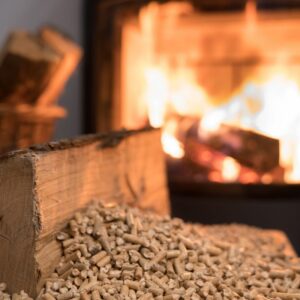As we head into the final days of summer, it’s time to think about the cool nights and shorter days that come with the approaching seasons. When autumn hits, there is nothing quite as comforting as the cozy warmth of a hardworking wood, gas, or pellet stove. We here at Top Cat Chimney understand the importance of keeping warm during the colder months, which is why we want to help you select the right appliance for your home.
So, which stove is right for you? Check out this simple guide and then give us a call or book online today. We love to help our community get cozy and warm.
Gas Stove: Effortless Convenience
Advantages
 Convenience: Unlike wood-fueled stoves, a gas stove is easy to use and requires little work to start and stop. Usually a simple flip of a switch or press of a button will have your fire going. This eliminates the need to gather, store, and load fuel into the stove.
Convenience: Unlike wood-fueled stoves, a gas stove is easy to use and requires little work to start and stop. Usually a simple flip of a switch or press of a button will have your fire going. This eliminates the need to gather, store, and load fuel into the stove.- Efficiency: Gas stoves are great at converting gas into heat for your home. They can be adjusted, as well, so you can control the heat output exactly to your liking.
- Cleaner Burning: Natural gas burns more cleanly than wood, which means creosote, soot, and other chemical byproducts take a lot longer to accumulate. This doesn’t mean that regular cleanings are not needed, but it does mean that the type of cleaning that needs done is typically less labor intensive and easier to maintain.
Disadvantages
- Lack of Ambiance: Gas stoves don’t tickle the senses in quite the same way as wood-burning ones do. They are silent, odorless, and they don’t create quite the same ambiance of burning wood logs.
- Dependence on Utilities: In order to use a gas stove, you must be hooked up into a gas supply that you have little control over. This means that utility bills can be higher, and you are susceptible to issues that are out of your control.
Wood Stove: The Classic Choice
Advantages
- Ambiance & Aesthetics: Wood as a source of fuel has been used for as long as man has made fire. A wood stove offers a traditional charm, making your space a cozy retreat that engages all the senses. The wonderful feeling of warmth, the beauty and trance-inducing light cast by flickering flames, the soothing crackle of burning wood, and the distinct smells given off by burning wood all work toward making a wood-burning stove a wonderful choice.
- Renewable Energy Source: Did you know that in 2020 the United States had 20% more trees than it did in 1970. This is because wood, unlike other energy sources, is able to be regrown. When burning wood, you are using a resource that is sustainable and renewable.
- Independence From Utilities: One of the most distinct advantages of using wood as a fuel source is the fact that you do not need electricity or gas to operate it. This means that, even during power outages or disruptions in the gas supply, you can remain warm.
Disadvantages
- Efficiency & Maintenance: As wood burns, it creates more chemical byproducts than other fuel sources. Ash, soot, and creosote are all born out of burning wood. The type of wood you use, its age, and the moisture content within it all contribute to the amount of these chemicals released during burning. However, regardless of those factors, wood will never burn as clean as gas or pellets. Regular cleaning is needed to keep buildup in your chimney from causing problems and increased risk of uncontrolled fire.
- Loading & Tending: In order to use wood, you must gather wood. You can buy it, which can be pricey, or you can gather it yourself. And in order to get the most efficiency from the wood, you will need to take it through the long process of drying and seasoning. This can take 6-9 months if stored correctly. This makes wood a more time- and labor-intensive (and sometimes more expensive) fuel source.
Pellet Stoves: A Blend of Efficiency & Sustainability
Advantages
 Automated Operation: Wood pellet stoves can automatically feed fuel into the firebox, which allows consistency and control over the heat output. This saves you from having to tend the fire and continue adding fuel.
Automated Operation: Wood pellet stoves can automatically feed fuel into the firebox, which allows consistency and control over the heat output. This saves you from having to tend the fire and continue adding fuel.- Efficiency: Pellet stoves often boast an efficiency rating over over 80%. They convert a large portion of the compressed wood pellets into heat, which is both effective and economical.
- Cleaner Burning: Pellets are made out of sawdust and wood shavings that would otherwise be disposed of. They are a highly eco-friendly option that produces fewer emissions than burning with wood, which makes for a cleaner burn.
Disadvantages
- Initial Investment: The upfront cost of purchasing and installing a pellet system can be higher than wood and gas stoves because there are a few more components involved.
- Pellet Storage: You need to keep a large amount of pellets on hand in order to maintain your ability to burn.
- Electricity Dependency: Pellet stoves require electricity to power the feeding and ignition systems within it. Power outages remove the ability to use the stove as a heat source.
What’s Best for You? We’re Here to Help
So what is your ideal stove? There is a lot to consider, but Top Cat Chimney can help. There are a lot of things to factor in, but we’re confident in our ability to help you find the right fit. Our experts will go over your space with you and make suggestions, so that you get everything you want from your stove – while fitting your lifestyle and budget.
Call us today at 724-664-6092 or book with us online, and let us help you make the best decision for your household.
